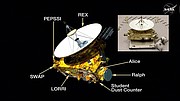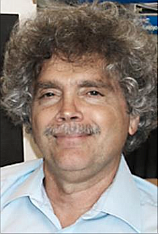What's up with Pluto?
“Space: the final frontier.”
Words that were just as true now as they were when William Shatner first uttered them in 1966 for the first episode of “Star Trek” on television.
Since then, modern technology has advance at a rapid pace through the efforts of many intelligent minds that want to see more of this final frontier.
One of these minds in particular is Stanford University senior research associate in electrical engineering and co-investigator of the New Horizons mission, Ivan Linscott.
Set to speak at the Northern Pacific Railroad Depot Museum in Wallace on April 11 at 6 p.m., Linscott will be regaling attendees with stories from his adventure to learn more about the former ninth planet — Pluto.
The presentation will focus on the NASA New Horizons spacecraft project that literally got off the ground in 2006 and provided researchers a wealth of new information about the dwarf planet nine years later.
Linscott’s role with New Horizons was in the development of the program’s Radio Science Experiment (REX), a device installed onto the spacecraft that can receive information in the form of electromagnetic waves (radio waves).
“What we do is we illuminate the surface of an object, like Mars or Pluto in this case, with radio signals that are transmitted from Earth, get reflected off the surface (or the sub-surface), and then they bounce back to an orbiter … or spacecraft going by,” Linscott explained.
Once the spacecraft (REX in particular) receives these waves, the information is decoded then sent back to earth for analysis.
A similar (but much less complex) technique called sonar is commonly used here on earth, where sound waves are emitted and then measured after they bounce off an object and return. These readings can be used for a variety of purposes, such as locating submarines or oil deposits under water. The information gathered by REX with the use of strong electromagnetic waves shot from Earth provide much more data than sound waves can, however.
“You can learn information about the nature of the surface, its texture, its composition, its sub-surface,” Linscott said.
“We broadcast these extremely powerful signals, they come to spacecraft, deflect off, and they are strong enough to see.”
Not to spoil Wednesday’s presentation, but since New Horizons sent back its data on July 13, 2015, a new light has been shed on Pluto — one that shows that it’s not just a crater-filled rock like many astronomers have believed it to be.
A massive heart-shaped nitrogen glacier, ripple-like methane mountains, a water-ice core, and new moons are just some of the many new discoveries that were uncovered as a result of the New Horizons mission. Linscott believes that Pluto got a rough deal when it was declassified from a planet to a dwarf planet in 2006. With these new findings, he is sure that Pluto has now given itself an identity and earned enough character to be in the league of the other recognized planets (even if a reclassification is highly unlikely).
As with human nature, much of the excitement surrounding New Horizons’ fly-by of Pluto centered around photos sent back by the spacecraft’s multi-spectral imager called “Ralph.” These images gave humanity its first real look at Pluto and its physical features.
Even though its not as ‘exciting,’ Linscott’s data that he and his team received from REX is certainly not any less important.
“Many of these situations (i.e., the nitrogen glacier and methane mountains) on Pluto are the only place in the solar system where they have been found,” he said.
Long before the project was green lit by NASA in 2000, Linscott had been working in the field of electro magnetics with other researchers. According to the Stanford Magazine, REX was initially developed in partnership with Johns Hopkins University under the direction of Len Tyler, a Stanford electrical engineering professor who was a principal investigator on the project before his retirement. This is when Linscott joined the team.
NASA wanted a project that would allow them to look at Pluto and Kuiper Belt objects, but that was also cost effective. It just so happened that REX fit the bill. With the support of Stanford University’s resources, Linscott and his team would spend six years fine-tuning REX and getting it ready for its mission.
As for why Ivan is now a (partial) resident of the Silver Valley and not down in California or the Northeast, you’d have to thank his wife, Margo Linscott.
Margo, a Silver Valley native and former electron microscopist, inherited several homes in the ’90s that stand in Burke. Since then, as a sort of side project, the couple have been slowly working to make them livable and restore them. Margo’s family was one of the first to settle into the Burke Canyon in the early 1900s and the proof is hard to miss.
According to the 1997 Spokesman Review article, “Staking A New Claim Couple Having Old Burke Houses Restored, And Uncovering Family History,” the couple’s incentive to fix the homes may be best explained by words penciled on wall panels by Margo’s grandfather:
“This house was built by Frank Richardson, fall of 1905, finished in spring of 1906. Married Dollie Ives in spring of 1903.” Another note reads: “Jan. 12 1906. 1st dinner in new house.”
Both Ivan and Margo will be at the Northern Pacific Railroad Depot Museum in Wallace on April 11 at 6 p.m. to talk more about the New Horizons mission and answer questions.





